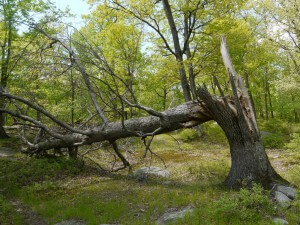Fallen trees can cause serious damage to property. Here are some tips to help you spot potential problematic trees that are at a greater risk for falling branches or even the entire tree itself.
Start from the Bottom
Check the tree’s base, take notice for hollow cavities or the presence of mushrooms could indicate a serious problem. Move on to checking the ground around the circumference under its canopy. Look for roots protruding up from the ground. Visible roots are not problematic in and of themselves, but if there’s other evidence to suggest that the tree is struggling, then protruding roots might mean that the tree is on the verge of toppling over.
Lightning
If you encounter a tree that’s missing a long streak of bark along its trunk, it was probably struck by lightning. Being composed mostly of water, trees are excellent conductors of electricity. When lightning hits the canopy, the bolt careens all the way day down to the roots, boiling sap in its wake and creating explosive steam. If there’s damage to one side of the trunk only, the tree might fully recover. But if bark’s missing on multiple sides, it’s likely that the tree isn’t going to survive.
Branch Inspection
Remove dead branches as they are the first to fall. On deciduous trees, dead branches either have no leaves or brown leaves in the spring/summer. With evergreen trees, look for brown needles and the absence of bark. If you successfully identify dead branches—and if those branches are easily accessible—go ahead and prune. Otherwise, call in a specialist.
Two-Trunk Trees
When trees have two or more trunks, be sure to look closely at the point where they meet. U-shaped connections between trunks are usually not a problem. A tight “V” shape, however, suggests a weak spot. If you’re worried about a particular tree, you can have a steel or elastic cable installed to keep it from splitting apart in high winds. But to be clear, this isn’t a project for the do-it-yourselfer; hire an experienced pro.
Call in the Pros
If any of the red flags discussed leave you uncertain about the health of a tree on your property, it’s best to call in a certified arborist. Besides having training and hard-earned knowledge, arborists also have specialized tools they can use to make sophisticated diagnoses far beyond the scope of this article.

